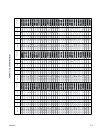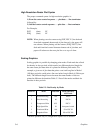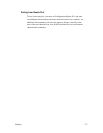
Graphics5–8
Bit Image Graphics
Bit image graphics are created by printing a series of vertical bit image data
bytes which represent the binary code bit pattern. This method utilizes the 1
or true bit from a binary data byte to print dot patterns. These data bytes are
actually the binary equivalent of ASCII character decimal values 0 through
255. When the data byte is rotated vertically, the result is a vertical data byte
pattern with the Most Significant Bit (MSB) at the top.
Characteristics of Bit Image Graphics
The binary data byte bit pattern for the ASCII character “A” (hex 41, decimal
65) is pictured in Figure 5–1.
• If you rotate this data byte clockwise, the result is a vertical data byte
pattern with the the most significant bit (MSB) at the top.
• If you print each 1 (true) bit as a dot, the result is a bit image plot of the
ASCII character “A.”
The relationship of ASCII character, decimal value, and bit image plot is
shown in Figure 5–2 .
• You can identify the data bytes by their binary, octal, hexadecimal, or
decimal equivalents. Combined, these numeric equivalents form a bit
image pattern.
• You can show each byte in a binary format, translate the byte to its
decimal equivalence, and use the decimal numeral (N) in a basic
command: CHR$(N).
• You can plot bit Image patterns for any 8–bit data byte (so long as the
eighth data bit is enabled) with decimal values ranging from 0 to 255,
since bit image plotting is not limited to printable ASCII characters.
• You can learn the the standard ASCII characters and their equivalents by
referring to the chart in Appendix A.
NOTE: Use bit image graphics in the Data Processing print mode (120 x 72
dpi). Vertical density variations in other print modes may cause
white horizontal bars or overlapping of adjacent graphics lines;
however, changing the line spacing can correct this problem. Refer
to Chapter 4 for specific density combinations.


















